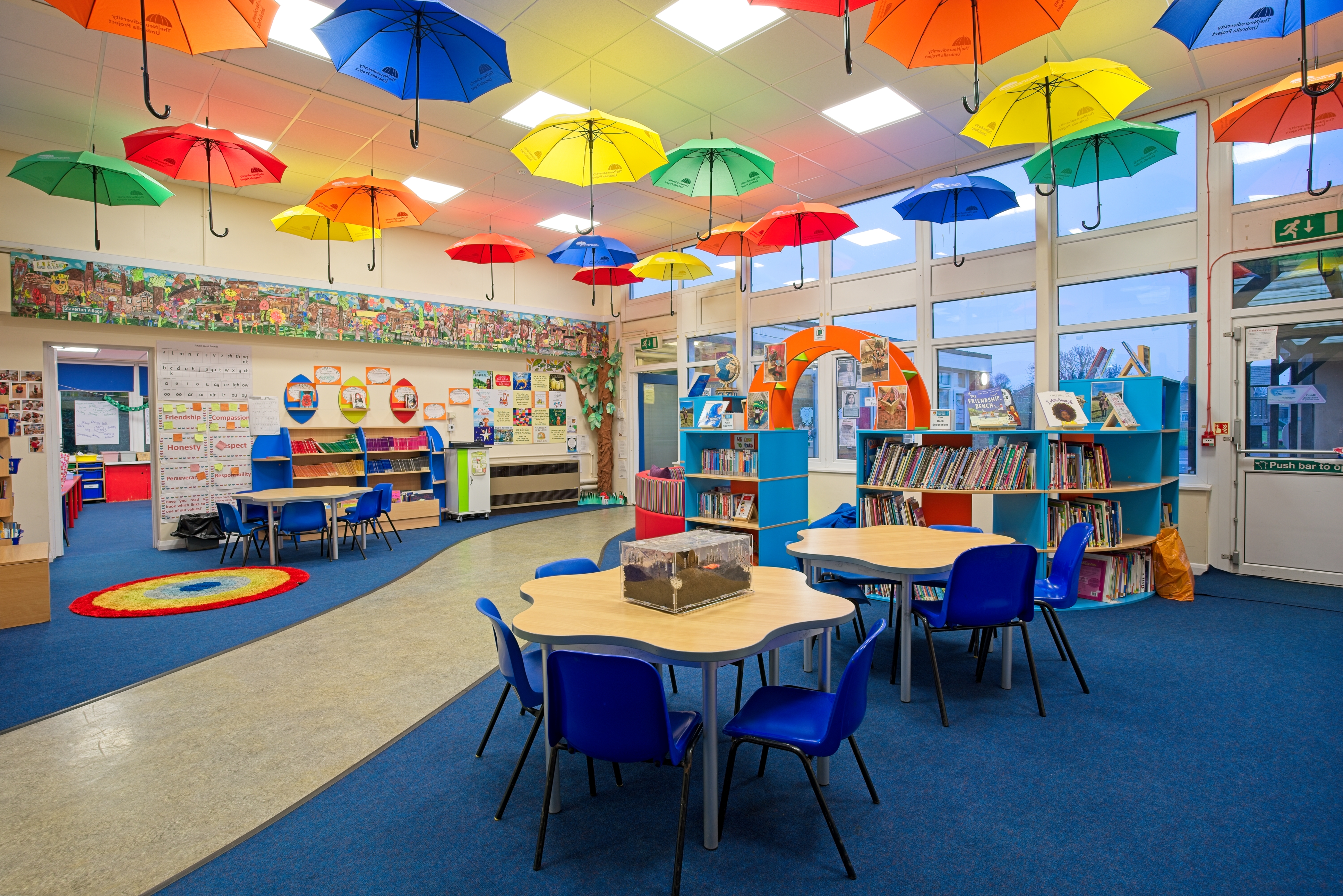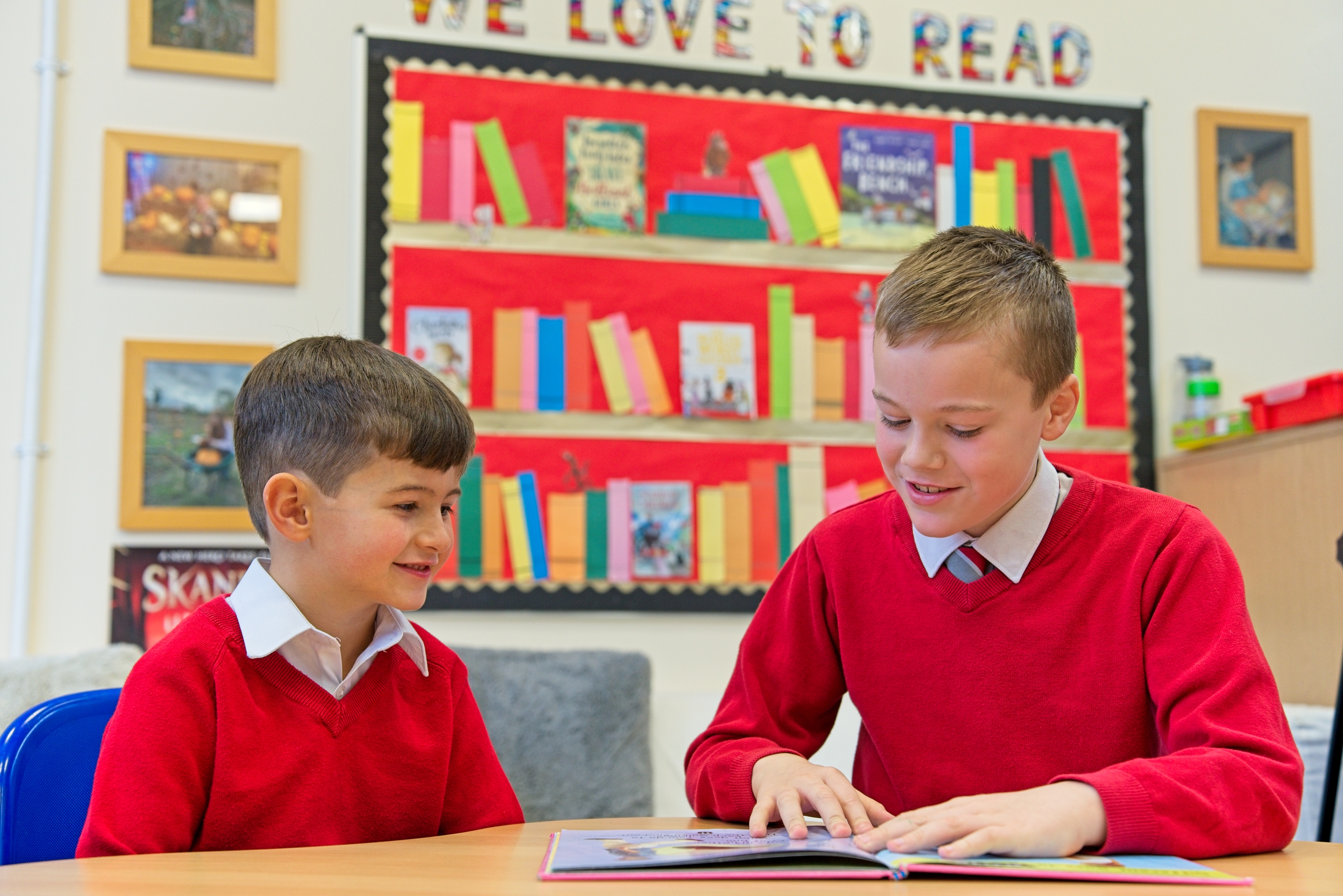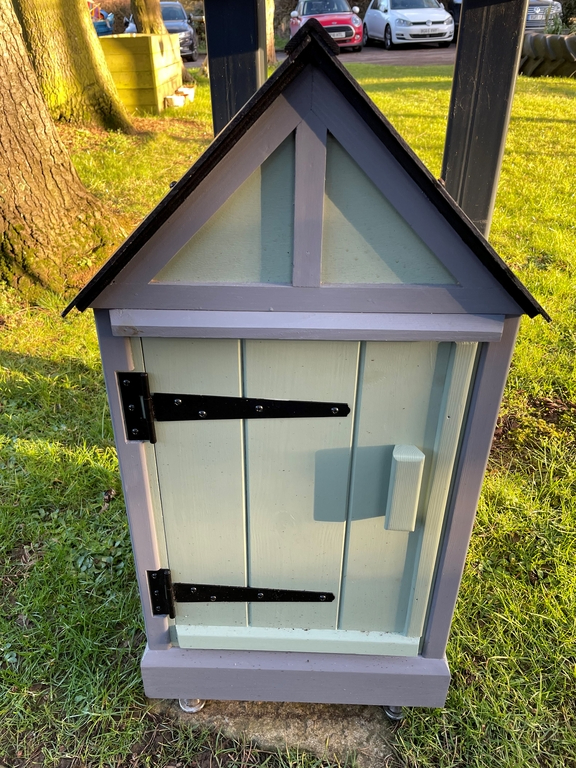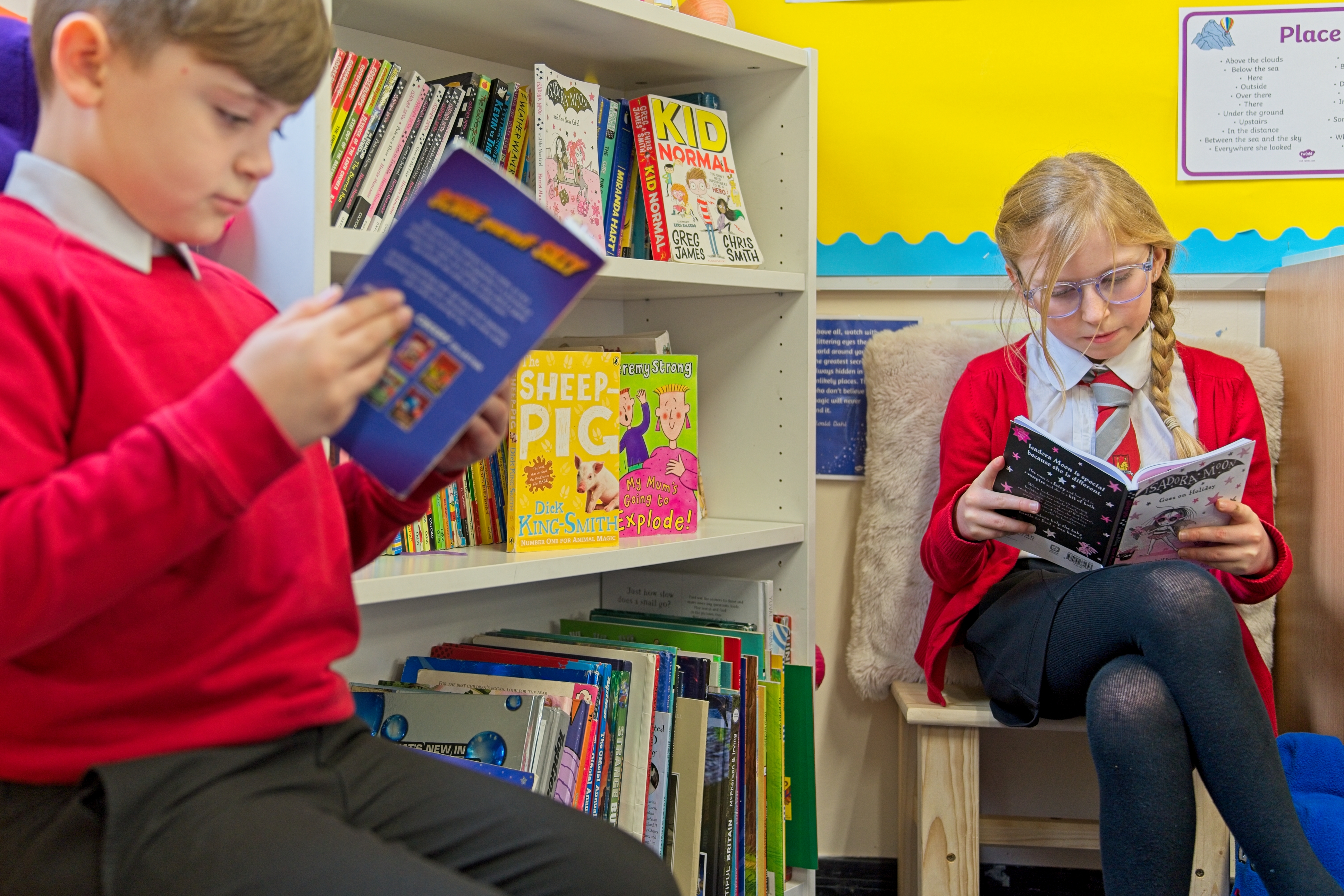
English Long Term Map
Reading at Staverton Primary School
At Staverton, we believe that reading is the gateway to learning. It is not only the foundation for academic success but also a lifelong source of joy, imagination, and discovery.
Our Vision: A Love of Reading
We want every child to leave Staverton as a confident, fluent reader who chooses to read for pleasure. Reading should be more than a school task—it should be an adventure. By sharing high-quality books together, exploring a wide range of genres, and encouraging daily reading at school and at home, we aim to:
- Inspire a lifelong love of stories, poetry, and information texts.
- Create opportunities for children to see themselves in books and to discover worlds beyond their own.
- Develop fluency, comprehension, and vocabulary in a way that feels purposeful and enjoyable.
Our Reading Structure
We follow a three-week cycle of reading lessons that balances depth of understanding with a wide reading experience.
Weeks 1–2: Deep Book Study
- Focus on a high-quality text that links to our writing curriculum.
- Explore characters, settings, themes, and rich vocabulary.
- Practise key skills such as visualisation, retrieval, inference, prediction, and discussion.
- Daily fluency practice using a structured approach: model → echo → choral → independent reading.
Week 3: Focused Comprehension
- Short extracts from a variety of texts, including fiction, poetry, and non-fiction.
- Explore vocabulary and meaning in detail.
- Practise answering a wide range of comprehension questions.
- Opportunities for independent application of skills, with teacher support as needed.
Progression Through the School
- Year 2: Guided reading structure all year.
- Years 3–4: Guided approach until Spring 2, then move towards greater independence.
- Years 5–6: Guided approach until Spring 1, then independent comprehension and deeper application of skills.
Building Fluency
Fluency is practised in every lesson through a gradual release model:
- Teacher model → Echo reading → Choral reading → Independent reading.
Children learn to read with expression, intonation, and confidence.
Why It Matters
By the time children leave Staverton, we want them to:
- Enjoy reading—choosing books for fun and for learning.
- Read widely and confidently—from classics to contemporary authors, poetry to non-fiction.
- Use reading to fuel their writing, creativity, and knowledge.
- Be ready for secondary school and beyond—with the skills and passion to continue their reading journey.
At Staverton, reading is not just part of the curriculum—it’s part of who we are as a school.
Reading in Key Stage One
In Key Stage One (KS1), reading is primarily taught through phonics lessons, following the National Curriculum's systematic phonics approach. Once children have completed their phonics programme, they transition to whole class reading in KS2, where they continue to develop their comprehension skills.
By making reading an integral part of our curriculum, we ensure that children develop the skills, confidence, and love of reading that will support them throughout their education.
How Parents Can Help at Home
Parents and carers play a huge role in nurturing a love of reading. Here are some simple ways you can support your child:
📖 Read together every day – even 10 minutes makes a big difference.
🌙 Make bedtime stories a routine – a calm and comforting way to end the day.
📚 Visit libraries and bookshops – let children choose books that interest them.
💬 Talk about books – discuss characters, make predictions, or share your own favourites.
🎧 Use audiobooks – great for listening on journeys and for reluctant readers.
✨ Be a reading role model – let your child see you enjoying reading too.
Together, school and home can build children’s confidence, fluency, and most importantly, their love of reading.

Writing at Staverton Primary School
At Staverton Primary, we believe that every child is a writer. Our aim is to give children the skills, confidence and inspiration they need to express themselves clearly, creatively and with pride.
How We Teach Writing
Writing is taught through a clear and supportive sequence. Children begin by exploring a high-quality model text so they can see what good writing looks like. Together, we talk about who the writing is for, why it was written and how the author makes it effective.
Step by step, children then learn new skills – such as using grammar, punctuation and vocabulary to create impact – and practise applying them in short pieces of writing. Over time, they build these skills into longer, independent pieces. Each unit ends with opportunities to edit and improve their work, helping them to develop accuracy and take pride in their achievements.
This approach is closely linked to the English National Curriculum, which asks children to write for different purposes and audiences, use grammar and punctuation effectively, and develop the stamina and imagination needed to produce extended pieces of writing.
Inspiring a Love of Writing
We want all children to enjoy writing as much as they enjoy reading. To make writing exciting and meaningful, we use:
- Engaging stories and texts as inspiration
- Drama, role play and discussion to spark ideas
- Cross-curricular links so writing has a real purpose (for example, writing a newspaper report in history or a diary entry in science)
By giving children real reasons to write and the chance to share their ideas, we help them see writing as a powerful way to communicate, imagine and create.
At Staverton, writing is not just about meeting curriculum expectations – it’s about helping children find their voice.
Spelling at Staverton
At Staverton, we focus on helping children develop strong spelling skills by learning a specific spelling pattern each week. From Year 2 onwards, spelling is taught daily, while in EYFS and Year 1, it is embedded within phonics lessons.
Building on Previous Learning
Reviewing previous learning is key to helping children retain and apply their spelling knowledge. That’s why each week’s spellings include some words that have been taught before—this might be from the previous week, month, or even the previous year.
Common Exception Words
Each year group also learns a set of Common Exception Words—words that don’t follow usual spelling patterns and can be trickier to master. To make learning these words more manageable, we include three or four of them in the children’s weekly spellings.
How We Teach Spelling
Daily spelling lessons at Staverton include:
✔ Introducing a new spelling rule
✔ Revisiting previously learned words
✔ Learning Common Exception Words
✔ Using words in context
✔ Breaking words into phonemes and syllables
Practising at Home
New spellings are sent home every Friday, and we encourage children to practise them at home. They can use the Look, Cover, Write, Check sheets provided or explore other fun ways to reinforce their learning.
Unlike traditional weekly spelling tests, we monitor and support children’s progress during lessons to help them use their spellings confidently in their writing.
If you have any questions, please feel free to speak to your child’s class teacher.
📌 Please note: Reception and Year 1 follow our Read Write Inc. Phonics Scheme, where spellings are integrated into their daily learning.
Phonics
We use ‘Read Write Inc’ to teach children phonics. The children are taught within the phase that is appropriate to their level of development. They are assessed on a regular basis and groups are set up accordingly. The phonemes (sounds) are systematically taught before the children are shown how to blend them for reading and segmenting them for writing. All staff received training in the teaching of phonics in October 2022 which ensures consistent delivery and nteractive sessions that engage and motivate the children.
Children take home a ‘phonics reading book’ linked to the phonic phase they are learning. Adults in school read regularly with children to check books provide opportunities for consolidation and challenge.
In EYFS and KS1 phonics is taught daily.
Phonics is taught through the ‘Speed Sounds’ lessons from the Read Write Inc programme. All KS1/EYFS staff are trained to deliver this programme and each session is structured as follows:
Say the sound: (e.g. ee)
Read the sound: (e.g. ee-what can you see?)
Review the sound: (spot the new sound in the pack).
Read the words: (phonics word cards-e.g. see, three, been, green, seen, sleep).
Review the words: (words from previous lessons).
Reading assessment: (children read a few nonsense words)
Spell with Fred Fingers: (words to spell choose 2-3 e.g. see, three, been, green, seen sleep).
Spell review: (children write 2-3 previously taught words).
As the children read the word cards, they are encouraged to look for ‘special friends’, ‘Fred Talk’ and finally to read the word. As they review the words, speedy reading is preceded with ‘Fred in your head’ to build up effective blending skills.
Alongside the structure of the Speed Sounds lesson, Read Write Inc is based on the 3Ps-pace, participation and praise. We believe that these foster positive learning behaviours.
Pace - Signals such as ‘my turn, your turn’ indicate when the children need to watch their adult and when it is time for them to have a go.
Participation - All children are expected to participate and work together co-operatively.
Praise - Children’s efforts are praised using genuine and specific feedback. ‘Team cheers’ are used to celebrate success.
Assessment and Groupings
Children are grouped according to their sound knowledge. The children are organised into groups across KS1 to ensure that each child is focussing on the set of sounds appropriate to their learning needs. Some groups will contain a mixture of Year 1 and Year 2 children. The children are assessed every half term and class teachers then review these phonic groups and set up new groups for the next term.
Where gaps are identified or progress is slower, these children receive extra phonics support.
Love of Reading
We promote a love of reading in our school in lots of different ways. We have an outdoor book hut where children can choose a book to take home and read. Any book donations gratefully received.


